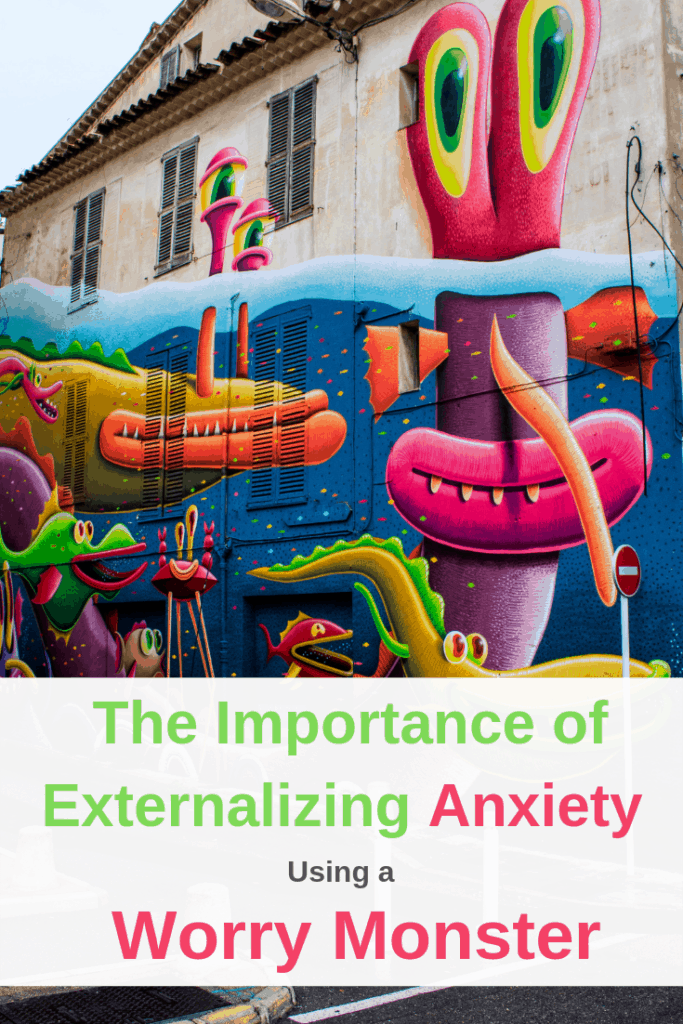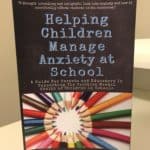
The Importance of Externalizing Anxiety
with a Worry Monster
Anxiety is a bully. It bosses your child around, tells them they are not good enough, and causes high amounts of fear. Suddenly, your anxious child begins to see anxiety as a part of them, bringing down their self-confidence and opinion of themselves. The best way to help your child battle anxiety is to name the worry monster, thus, making sure that the anxiety is seen externally. This process allows children to keep their own identify strong while externalizing the anxiety as the bully.
It is important that you explain to your child that the anxious thoughts and feelings are being created by a worry monster or bully. This worry monster or worry bully is trying to scare you but you do not have to listen to it. This idea separates the anxiety from the identity of the child.
Use examples of kids who may be mean or bossy at school to illustrate the idea of the worry monster in their head. Just as you would walk away from the bully at school, and not listen to them, you do not have to listen to the one in your head.
Naming the Worry Monster
The task of naming the worry monster should be given to the child. There are no guidelines when deciding on a name, simply let your child create a name in which to reference when they are being told false information by the worry monster. Some children select a name tied to anxiety, such as Brain Bully, Brain Monster, Meanie, Mr. Perfect, Mr. Negative, or Amy G. Dala (from the word amygdala). Other children pick names simply because they like the name. My daughter named her worry monster “Sam”. When selecting her name, she wanted a name in which she didn’t know any kids with that name. As a second-grader, she had never met a “Sam”.
Drawing the Worry Monster
Once your child has named their worry monster, have them draw a picture of what they imagine it looks like. Encourage them to be creative and take their time, adding colors and details. Below is the worry monster, Sam, that my daughter drew in second grade. Hang this image in a visible location, reminding everyone in the home that the worry monster is the anxiety, not your child.
Putting Anxiety in its Place
Now that you and your child have a name and an image of this awful worry monster, it is time to start putting the anxiety in its place! When your child begins to feel anxious, you and your child must refer to the worry monster by name rather than talking directly to your child. When you talk to the worry rather than the child, it takes away the negativity the child feels about themselves. This externalization relieves some of the identity of anxiety as part of the child. It is important that children realize that they hold the power over the anxiety rather than the anxiety controlling their thoughts and feelings.
Examples of How to Address the Worry Monster
A child with perfectionist tendencies starts to feel anxious over making a mistake. The child says to the worry, “Mr. Perfect, I know you are trying to tell me mistakes are bad but I know that it is ok to make a mistake. I am not going to listen to you.” As a parent, you might say, “Mr. Perfect, I see that you are trying to tell [child’s name] that he has to be perfect, but we all know that nobody is perfect and that is ok.”
A child with separation anxiety starts to worry about leaving to go to school. As a parent, you can say, “It sure looks like Bossy Pants is trying to scare you. I know Bossy Pants is loud and scary but you are brave and know that I will see you as soon as school is finished. Be brave and don’t listen to mean old Bossy Pants.” A child may say, “Bossy Pants is scaring me about school right now. I am telling her that she is just a bully and even though I feel scared, I know I will see you after school.”
A parent who notices their child, who has fear about germs, is avoiding the doorknob. The parent may say, “I see that Meanie is making it hard for you to open the door right now. What can you say to Meanie to make him quiet down?” A child may say, “Leave me alone Meanie. Go pick on someone else. I am going to open this door and go outside.”
Externalizing the anxiety by naming and referring to it as a worry monster, does not make the anxiety disappear, but it separates the anxiety from the child’s identity. The more often that your child can re-frame his or her thinking by standing up to the worry monster, talking back to it, and defying what it says, the more success a child will have in moving lessening the anxiety.
 The topic of externalizing a worry monster is detailed in the new book, Helping Children Manage Anxiety at School. Check it out for more information.
The topic of externalizing a worry monster is detailed in the new book, Helping Children Manage Anxiety at School. Check it out for more information.
Related: I recently came across Shy Mommy Life, where a mother with social anxiety wrote a letter to her anxiety. It showcased that creating a worry monster is not the only way to externalize anxiety. Writing a letter may be a way for older children to talk to their anxiety.

How helpful are these practices for parents to work with children to cope with their fears and worries! These practices, I feel would work wonders for the adults as well in handling their own anxieties.
Thank you. I agree that adults can benefit as well. I have used them since learning about it for my daughter.
I love this! I’m an adult with anxiety, but I feel like without knowing, I have used a similar strategy to deal with my own “worry monster”. I’m a creative writer and when I first got diagnosed, I felt like it would be an interesting exercise to try and turn my anxiety into one of my characters, to explore its strengths and weaknesses. Then I did that. I gave it a name, an appearance, hobbies, the whole package, haha. Now, I often refer to my anxiety by its name. When its really bad, I catch myself saying things like “Come on, Zitty, let me do this!” Hahaha! It works! Even as an adult. ;P
That is wonderful. Since learning about it for my daughter, I have applied it to myself. I find that talking to the anxiety as something other than yourself keeps your dignity and self-worth in place…it isn’t you, it is the anxiety. Thank you so much for sharing.
I love the idea of a worry monster! I’m 34 and only just now learning that I’m not my anxiety. How great to teach this lesson to my kids in such a tangible way!
I am 39 and just learned about it a few years ago during my daughter’s therapy. I think it is a great idea. While I have never named my anxiety, I do work on reminding myself that it is anxiety and I do not have to listen to it bully me around! Children love it though…even those with small worries like being scared of the dark or riding on the school bus (rather than just who have anxiety over everything). I hope your children like it too!